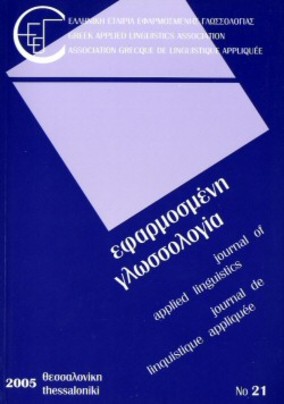Vocabulary size in English course books : the case of Greek primary schools
Part of : Εφαρμοσμένη γλωσσολογία ; No.28, 2013, pages 129-148
Issue:
Pages:
129-148
Author:
Abstract:
This paper is part of an MA research and attempts to enrich the literature in vocabulary issues with regard to English course books in Greek state primary schools by investigating the size of vocabulary in both the old and new English course books taught in primary schools. The corpus-based analyses of these course books at a variety of levels (unit, book, and series) render valuable data concerning the actual size of vocabulary in terms of tokens and types in both of these series. The findings are expected to be of great value to practicing teachers and course book writers.
Subject (LC):
Notes:
Περιέχει γράφημα, πίνακες, σημειώσεις και βιβλιογραφία
References (1):
- Astika, G.G. (1993). Analytical assessment of foreign students' writing. RELC Journal,24,61-72.Bratsoli, A. and A. Diamantiduu (2009). English 4th Grade: Teacher's Book. Athens:Ministry of National Education and Religion.Cameron, L. (2001). Teaching Languages to Young Learners. Cambridge: CambridgeUniversity Press.Coady, J., J. Magoto, P. Hubbard, J. Graney and K. Mokhtari (1993). High frequencyvocabulary and reading proficiency in ESL readers. In T. Huckin, M. Haynes and J.Coady (eds), Second Language Reading and Vocabulary Learning. New Jersey: Ablex,217-218.D’Anna, C., E. Zechmeister and J. Hall (1991). Toward a meaningful definition of vocabulary size. Journal of Reading Behavior, 11: 109-122.Gabrielatos, C. (2005). Corpora and language teaching: Just a fling or wedding bells?[on line]. Available: http://tesl-ej.org/ej32/al.html [January 2012],Goulden, R., P. Nation and J. Read (1990). How large can a receptive vocabulary be?AppliedLinguistics,11:341-363.Gu, Y. and R. Johnson (1996). Vocabulary learning strategies and language learningoutcomes. Language Learning, 46: 643-697.Heatley, A., P. Nation and A. Coxhead (2002). RANGE and FREQUENCY pro-grams[on line]. Available: http://www.vuw.ac.nz/lals/staff/Paul_Nation [January 2012].Hirsh, D. and P. Nation (1992). What vocabulary size is needed to read unsimplifiedtexts for pleasure? Reading in a Foreign Language 8/2: 689-696.Hsueh-chao, M. and P. Nation (2000). Unknown vocabulary density and reading comprehension. Reading in a Foreign Language, 13/1: 403-430.Hunston, S. (2002). Corpora in Applied Linguistics. Cambridge: Cambridge UniversityPress.Konstantakis, N. and T. Alexiou (2012). Vocabulary in Greek young learners’ Englishas a foreign language course books. The Language Learning Journal, 40/1: 34-45.Läufer, B. (1992). How much lexis is necessary for reading comprehension? In H. Bejointand P. Arnaud (eds), Vocabulary and Applied Linguistics. London: Macmillan, 126-132.Läufer, B. (1997). The lexical plight in second language reading: Words you don ’t know,words you think you know, and words you can’t guess. In J. Coady and T. Huckin(eds), Second Language Vocabulary Acquisition: A Rationale for Pedagog y. Cambridge:Cambridge University Press, 20-34.Läufer, B. (2010). Form focused instruction in second language vocabulary learning. InR. Chacon-Beltran, C. Abello-Contesse, M. Torreblanca-Lopez and M.D.Lopez-Jimenez(eds), Further Insights into Non-native Vocabulary Teaching and Learning.Bristol: Multilingual Matters, 15-27.Läufer, B. and P. Nation ( 1995). Vocabulary size and use: Lexical richness in L2 writtenproduction. Applied Linguistics, 16/3: 10-14.Laurence, A. (2009). Antwordprofiler, version 1.200w [Computer Software], Tokyo,Japan:Waseda University. Available: http://www.antlab.sci.waseda.ac.jp/ [January2013],Mattheoudakis, M. and T. Alexiou (2009). Early foreign language instruction in Greece:Socioeconomic factors and their effect on young learners’ language development.In M. Nikolov (ed.), The Age Factor and Early Language Learning. New York: Moutonde Gruyter, 227-252.Mattheoudakis, M. and K. Nicolaidis (2005). Stirring the waters: University INSET inGreece. European Journal of Teacher Education, 28/1: 49-66.Meara, P. (1980). Vocabulary acquisition: A neglected aspect of language learning. LanguageTeachingandLinguistics:Abstracts,13/4:221-246.Milton, J. and P. Meara (1998). Are the British really bad at learning foreign languages?LanguageLearningJournal,18:68-76.Milton, J., J. Wade and N.Hopkins (2010). Aural word recognition and oral competencein a foreign language. In R. Chacon-Beltran, C. Abello-Contesse, M. Torreblanca-Lopez and M.D.Lopez-Jimenez (eds), Further Insights into Non-native VocabularyTeachingandLearning.Bristol: Multilingual Matters, 83-97.Milton, J. and P. Vassiliu (2000). Frequency and the lexis of low level EFL texts. In K.Nicolaidis and M. Mattheoudakis (eds), Proceedings of the 13 th International Symposiumon Theoretical and Applied Linguistics. Thessaloniki: Aristotle University, 444-455.Nagy, W. and R. Anderson (1984). How many words are there in printed school English?ReadingResearchQuarterly,19:304-330.Nation, P. (1990). Teaching and Learning Vocabulary. Massachucetts: Heinle & HeinlePublishers.Nation, P. (2001). Learning Vocabulary in Another Language. Cambridge: CambridgeUniversity Press.Nation, P. (2006). How large a vocabulary is needed for reading and listening? TheCanadianModernLanguageReview,63/1: 59-82.Nation, P. (2008). Teaching Vocabulary: Strategies and Techniques. Boston: Heinle Cen-gage Learning.Nation, P. and R.Waring (1997). Vocabulary size, text coverage and word lists. In N.Schmitt and M. McCarthy (eds), Vocabulary: Description, Acquisition and Pedagogy.Cambridge: Cambridge University Press, 6-19.Pavicic, V. (2008). Vocabulary Learning Strategies and Foreign Language Acquisition.Clevedon: Multilingual Matters.Pro dro mou, L. (2008). English as a Lingua Franca: A Corpus-based Analysis. London:Continuum.Qian, D. (1999). Assessing the roles of depth and breadth of vocabulary knowledge inreading comprehension. The Canadian Modem Language Review, 56: 283-307.Read, J. (1997). Vocabulary and testing. In N. Schmitt and M. McCarthy (eds), Vocabulary:Description, Acquisition, and Pedagogy. Cambridge: Cambridge University Press,41-60.Read, J. (2000). Assessing Vocabulary. Cambridge: Cambridge University Press.Sanaoui, R. (1995). Adult learners’ approaches to learning vocabulary in second languages.Modem Language Journal, 79: 15-28.Schmitt, N. (1997). Vocabulary learning strategies. In N. Schmitt and M. McCarthy(eds).Vocabulary:Description,Acquisition,andPedagogy. Cambridge: CambridgeUniversityPress,41-60.Schmitt, N. (2000). Vocabulary in Language Teaching. Cambridge: Cambridge UniversityPress.Schmitt, N. and M. McCarthy (1997). Vocabulaiy: Description, Acquisition , and Pedagogy.Cambridge:CambridgeUniversity Press.Sougari, A. and N. Sifakis (2007). Mono-cultural or multi-cultural EFL: What do teachersthink?InF.Boers,J.Darquennes, and R. Temmerman, (eds), Multilinguialismand Applied Comparative Linguistics, Vol. 1: Comparative Considerations in SecondandForeignLanguageInstruction.Newcastle:CambridgeScholar Press, 193-211.Staehr, L.S. (2008). Vocabulary size and the skills of listening, reading and writing. LanguageLearning Journal, 36: 139-152.Stoffer, I. (1995). University foreign language students’ choice of vocabulary learningstrategiesas related to individual difference variables. Unpublished Doctoral Thesis,Universityof Alabama.Zapounidis, T. (2010). The old and new English course books of Greek State primaryschools:A corpus-based study of vocabulary size, frequency and recycling. UnpublishedMA Thesis,Aristotle University of Thessaloniki.Zimmerman, H.J. (2004). The role of vocabulary size in assessing second language proficiency.UnpublishedMAThesis,BrighamYoungUniversity.




